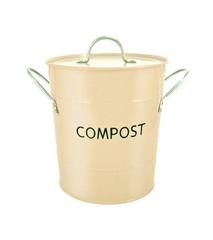What happens when you throw an apple core in the bin? No big deal, right? – it will just compost naturally in landfill. Nature doing its job. Turns out not what happens, which is why kitchen waste composting is so important.
A landfill is not a forest floor – when compacted, organic matter doesn’t have enough air to decompose naturally. Instead, it goes into anaerobic decomposition – a type of decay that releases methane, a greenhouse gas 25 times more powerful than CO2.
One little apple core may seem like nothing, but add up all the world’s food scraps, and the environmental impact is staggering.
If food waste were a country, it would rank as the third highest national emitter of greenhouse gases after the US and China.
- United Nations
Look on the bright side – at least we don’t have to wait for big corporates or government to act on climate change – we can start making a difference ourselves. Firstly, by reducing food waste we produce. And then, by composting whatever is leftover - in other words, putting the 5th "R" (Rot) into action!
There are many different composting methods, so you’re sure to find one that suits your lifestyle:
Many local councils have food waste recycling – where kitchen waste is taken to a composting facility and turned into fertiliser. The council can provide a food caddy to put out with the bins, so you just need a small bucket with compostable liners for your kitchen.

Above: Keep a compost bucket in the kitchen to collect scraps
Compost like a boss. Maybe you’re put off by the idea of rotting, stinky food in your garden. But done properly, kitchen waste composting is actually a stink-free, easy and rewarding way to create nutrient-rich soil. Even celebrities like Rosario Dawson and Adrian Grenier are getting into it!
Composting is one of nature's most astonishing and regenerative processes. Learn more at TheCompostStory.com
Worm farms are great for beginners - compact and simple to use. Once you get your container, all you need is some dirt, strips of newspaper, and of course, composting worms. Add leftover food scraps, then let the worms poop their magic.

Above: Wiggle it! A wormery is the perfect kitchen waste composting system for beginners
Bokashi is a Japanese composting method, which is a little bin that sits under the sink and has no smell - great for small spaces. Add Bokashi chips and food scraps, and it will break down into a nutrient-dense liquid that can be diluted and added to your garden.

Above: Sayonara, food scraps. A Japanese bokashi bin can be used indoors
If you’re really tight on living space, but serious about composting food waste, a powered indoor composter might be for you. They come with a hefty price tag, but will make your life so much easier, and last forever, too.

Above: Turn food scraps into soil within 3 hours with a powered composter
Want to keep it old-school? If you have a terrace or a nice sized courtyard, you can get an open bottom compost bin that lets worms come up from the earth.
Above: An outdoor compost converter converts your food waste into nutrient-rich food for the garden
Have you tried kitchen waste composting? Which method works best for you? Share in the comments below and inspire others!

